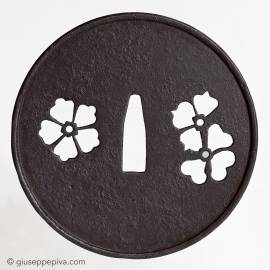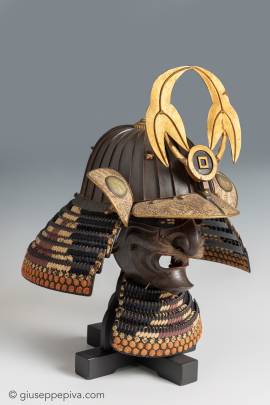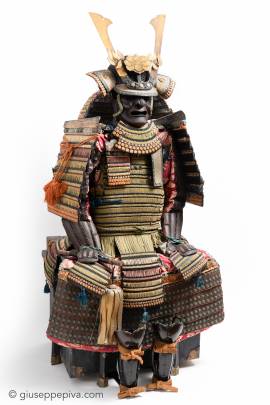Mid Edo Period (1615-1868) 18th Centuryron with openwork decoration (sukashi)96 mm, maru-gata with beveled raised rim (takadotemimi)Thickness at the seppadai: 3 mm. Thickness at the rim: 6 mmA karabana flower on one side and a kikyo over a sakura on the other create a well-balanced composition. The delicate subject, careful finish and refined iron indicate a tsuba of high quality.Karabana design had been imported from China and do not resemble any real Japanese flower; this indicates that the decoration is actually referring to family crests and not to natural...
WORKS FOR SALE
Helmet and samurai maskEdo period, early 19th centurySignaturesKabuto: Nisshū ju KanemitsuMenpō: Sukemitsu The 32-plate helmet of suji-bachi type, consisting of 32 iron plates finished in sabiji-nuri, folded upward. On the diagonals are four shiten-no-byo rivets and related hibiki-no-ana.The menpō is beautifully finished, with sharp edges and meticulous decoration.Both the protection of the neck (shikoro) and that of the throat (tare) are bound with silk of three colors, echoing the omodaka (sagittaria leaf) motif popular between the twelfth and thirteenth centuries in ō-yoroi-type armor...
Samurai armor in revival styleEdo Period, 17th to 18th centurySignature on kabuto: Jōshū jū Saotome Ietada Kabuto [helmet]: A russet iron (tetsu sabiji) sixty-two plate kabuto, each mounted with twenty-five small tapered standing rivets (ko-boshi) of decreasing size; the front plate, larger than the others, is fitted with two lines of rivets, while the rear one is left empty, for a total of 1.550 rivets.The typical "Saotome-byo", an extra rivet which is almost an additional signature of the Saotome armorers, is visible inside.Maedate [helmet crest]: Kuwagata (stylized...
Copyright © 2016 - giuseppe piva - VAT: 05104180962










